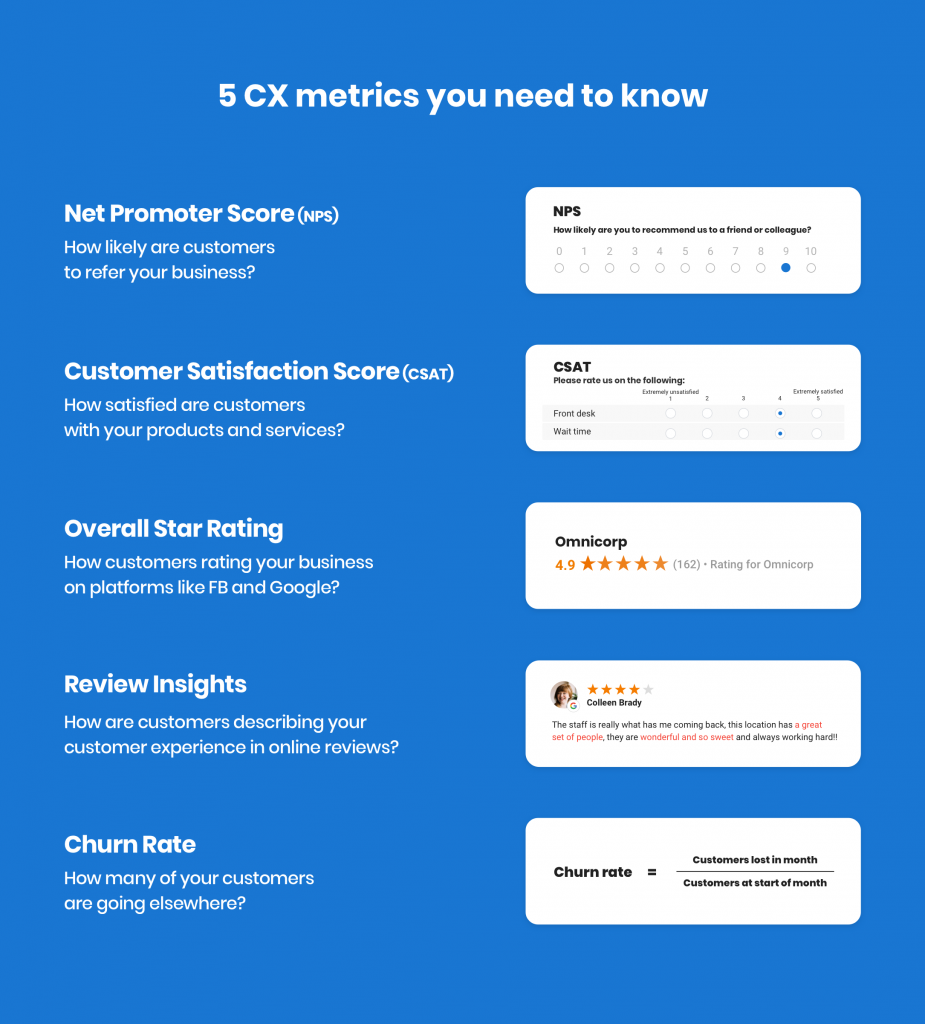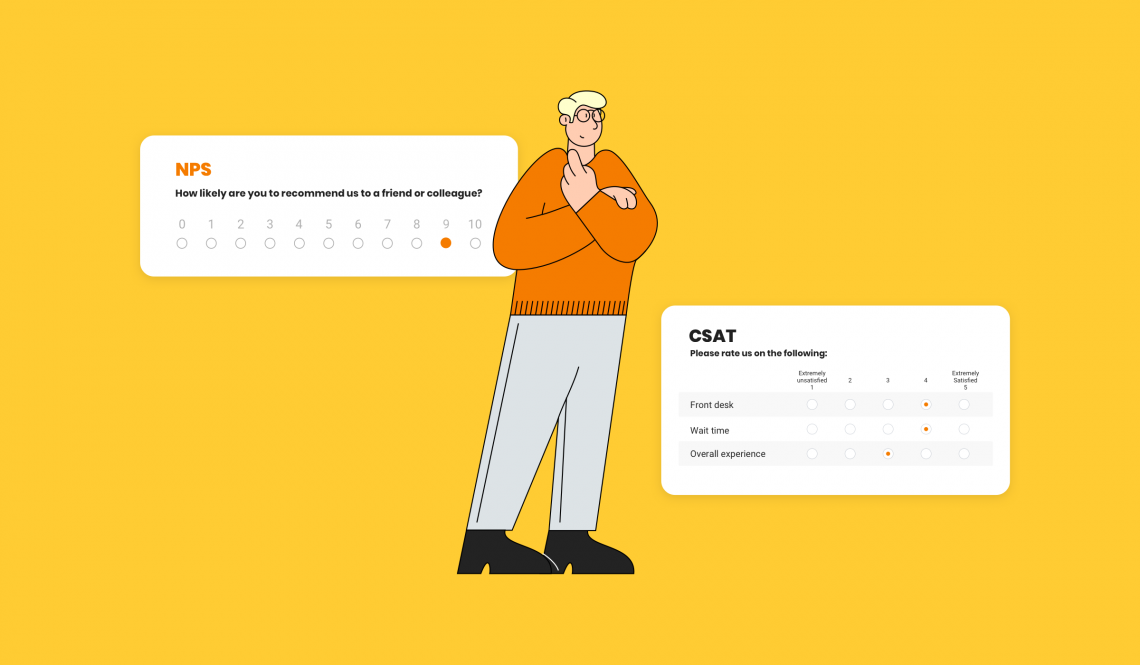Without accurate measurement of customer sentiment, delivering great experiences is close to impossible. Without the right data and the right metrics, you and your team may be shooting in the dark in your attempts to improve business operations. Let’s discuss why customer experience (CX) is so crucial, which metrics your business needs to track, and how you can reliably wow your customers in every interaction.
Table of contents
- The value of customer experience
- A holistic approach to customer experience
- 5 customer experience metrics: Pros and cons
- Best practices for collecting customer feedback
- In conclusion
The value of customer experience
In the experience economy, customers don’t expect their relationship with your business to end with a purchase. Whether they realize it or not, consumers expect value across the customer journey. They want to feel like brands are listening to their needs and their desires. They don’t just want goods and services – they want winning experiences.
Customer loyalty is now earned by delivering memorable experiences and forging genuine connections. Studies show that customer experience drives over two-thirds of customer loyalty, outperforming brand and price combined. Higher loyalty then leads to higher revenues. Businesses that prioritize customer experience are three times more likely to reach their top business goals.
A holistic approach to customer experience
To win in the experience economy, businesses need to consider the entire customer journey across all channels and over time. To accomplish this goal, managers need to be measuring the performance of all their customer experience initiatives.
Focusing on just one metric is often not enough to adequately measure the impact of these different initiatives across the entire customer journey. Customer experience is simply too complicated to be captured by a single number. Instead, successful managers track a variety of metrics that can help them understand individual touchpoints as well as the customer’s perception of their brand.
5 customer experience metrics: Pros and cons
Here are five customer experience metrics that your business should be tracking.

1. Net promoter score
To determine net promoter score (NPS), businesses typically start by asking this question:
How likely are you to recommend our business on a scale from 0-10?
Customers are then segmented into three groups based on their answers.
- 0-6: Detractors
- 7-8: Passives
- 9-10: Promoters
The score is then calculated by subtracting the percentage of detractors from the percentage of promoters.
Here are some of the pros and cons of net promoter score.
Pros of Net Promoter Score
- Easy for customers: When taking a net promoter score survey, all your customers have to do is click the score they most closely agree with. The process is simple and does not require a significant time investment.
- Identifies potential promoters: When a customer answers with a “9” or a “10”, you will immediately know that they are highly likely to promote your brand. You can then reach out to these customers and ask if they’d be willing to refer your business to friends and social media followers.
- Higher scores mean more revenue: Studies have shown that higher NPS scores correlate with higher revenue. According to the London School of Economics, a 7-point increase in NPS correlates with a 1% increase in growth.
Cons of Net Promoter Score
- Net promoter score lacks context: While net promoter score is a simple number that’s easy to keep track of, it’s meant to measure the customer’s overall relationship with your business. It doesn’t provide insight into what specific touchpoints aren’t meeting customer expectations.
- Net promoter score may be too simple: An article by the Harvard Business Review found that customers’ relationships with brands are often more complicated than a simple number. For example, a customer may love a retailer’s products but at the time be dissatisfied with their customer service.
- Net promoter score removes passives from the equation: Since NPS is based on promoters and detractors, passives are simply not included in the final number. However, it’s important to understand why customers who are “on the fence” feel this way and what can be done to fix their issues to deliver a truly best-in-class customer experience.
2. Customer satisfaction score
A customer satisfaction score (CSAT) tracks how customers feel about your products and services. Typically, businesses ask a question like this:
How would you rate your overall satisfaction with the [product/good/service] you just received?
- Very unsatisfied
- Unsatisfied
- Neutral
- Satisfied
- Very satisfied
The customer satisfaction score is then measured by dividing the number of positive responses by the total number of responses.
Pros of customer satisfaction score
- Understand the customer throughout the journey: With a customer satisfaction score, you can see how customers perceive your brand through a variety of different touchpoints. You will then be able to identify and take action on specific problem areas.
- Easy to understand: Just like NPS, CSAT is a simple metric for customers to rate your customer experience. All they have to do is click a button to give you feedback. Your team also has a simple percentage score that they can use to estimate overall satisfaction.
- Rating is variable: While businesses typically use the 5-point scale, you can be flexible for your customer base. You can consider using emojis or stars if you find that your customers are more comfortable with them.
Cons of customer satisfaction score
- Cultural differences: Studies have shown that customer satisfaction varies in different cultures. Americans are more likely to choose extreme options, while people in Japan are more likely to choose middle-of-the-road options like “Satisfied” or “Unsatisfied”. Keep this in mind if your team is operating internationally.
- “Satisfied” is subjective: A rating of “5” on a customer satisfaction survey can mean two different things to two different people. For some customers, being satisfied with a product or service means they had a great experience. For others, it means they just had an “okay” experience.
- Does not reflect overall experience: Customer satisfaction score is meant to measure specific touchpoints, but not the customer’s overall relationship with your business. A customer may leave a high satisfaction score after a positive experience with your business but might have a negative view of your brand overall.
3. Overall star rating
When you go on a review site like Google Business Profile, you’ll see an overall star rating on a scale from 1-5. While overall star rating helps customers using search determine the quality of your business’s services, it can also be a valuable metric for improving your customer experience.
Pros of overall star rating
- Easy to track: The biggest advantage of overall star rating is that it’s easy to track. If you want to see your star rating on Google, simply do a search for your business’s name.
- Star rating correlates with revenue: Just like NPS, higher star ratings mean more revenue. Studies have shown that a 1-star increase in overall star rating leads to a 5-9% increase in revenue.
- Low ratings can help identify problems in CX: Customers who leave reviews often leave a written description explaining their reasoning for their star rating. If you see the same issues coming up again and again in negative reviews, take note. These might be problem areas that need improvement.
Cons of overall star rating
- Susceptible to negative reviews: The customers who are most likely to go online to review your business are those who’ve felt that they’ve had a strongly negative experience. As a result, it’s possible that your business’s review rating is skewed downwards. To counteract this and get more balanced feedback, you can solicit reviews from all of your customers by sending review request texts and emails after purchases.
- Small sample size: Not every business has enough reviews for an overall star rating to be a helpful metric. Again, taking active steps to solicit reviews from customers can help to solve this problem.
- Maybe skewed by past ratings: Your overall star rating on sites like Google is the average of every review that’s been posted. Unfortunately, that means your star rating may be affected by the experiences of customers in the distant past. It can be helpful to instead look only at reviews posted in the last year.
4. Review insights
Overall star rating can help you understand the customer’s overall sentiment towards your business. Still, it’s difficult to quantify how well you’re doing in specific categories like “customer service” or “wait time”. That’s where a Natural Language Processing engine can help. A platform like Birdeye can analyze your reviews and find areas that customers are mentioning the most. The platform will then grade your performance in these categories in an A-F grading system.
Pros of review insights
- Understand unstructured data: Manually looking through hundreds of online reviews for insights is a difficult task. Insights help to automate this process so that your team can identify potential issues with little effort.
- Get feedback on specific categories: Because customers often mention different areas of the customer experience within reviews, insights can help you identify potential issues and make changes accordingly.
- Measure different locations: Multi-location businesses often have trouble measuring CX in individual locations. Review insights show which locations are having the most issues.
Cons of review insights
- Need a platform with a reliable Natural Language Processing algorithm: To get actionable insights from your online reviews, you’ll need a platform with an NLP engine like Birdeye. Because of the sheer volume of reviews that need to be analyzed, there’s simply no way around this.
- Sample size: Just like overall star rating, review insights will not be helpful if your sample size is too small. Again, the best way to combat this problem is by actively soliciting reviews from customers.
- Complication: Because review insights give grades on multiple different categories, it’s more complicated than some of the other metrics that we mentioned. While NPS is an easy metric to communicate with other members of your organization, it’s difficult to do this with insights.
5. Customer churn rate
Churn rate is the rate at which customers stop doing business with you in a certain period of time. For example, imagine a business that has 100 existing customers one year, but only 90 of them continue using their services the next year. The business’s churn rate for the year is 10%.
Pros of customer churn rate
- Saves money for your business: It’s been estimated that it’s 5-25x more expensive to attract new customers to your business than to keep your existing ones. As a result, focusing on reducing customer churn can lead to big cost savings.
- Identify at-risk customers: By measuring the churn rate and studying the characteristics of customers who leave, you can get a better understanding of which one of your customers is more at risk to stop using your services in the future. You can also develop an action plan to make sure these customers stay on.
- Understand problems with your business: Digging into the reasons why your customers churn will often help you identify issues with your business operations. For example, you may find that customers who leave your business are upset about customer service.
Cons of customer churn rate
- Different customers have different values: While the churn rate treats every lost customer as the same, this isn’t necessarily the case. Losing a customer who was once an active promoter of your brand may hurt your business, in the long run, more than losing a passive customer.
- Reducing churn isn’t always necessary: Some managers are alarmed by any level of churn. While it’s tough to see customers leaving your business, some churn is inevitable. Customers who leave may never have been in your target market in the first place.
- Churn may be hard to calculate: If you’re working in a business with a subscription model, calculating the churn rate is straightforward. However, for businesses that aren’t using a subscription model, it can be difficult to determine how many customers stayed and left over a certain period of time.
Best practices for collecting customer feedback
Now that we’ve discussed a few different metrics for measuring your customer experience, let’s break down a few best practices that can help you get a comprehensive view of your business operations (with a couple of examples from Birdeye customers).
Use reviews and surveys together
We’ve seen that reviews and surveys together can be great tools for identifying and resolving issues in customer experience. Hillcrest Animal Hospital uses reviews to find the areas that patients are complaining about most often. The team then uses surveys to collect in-depth feedback and better understand how these issues can be solved.
Reply promptly
Every business should aim to respond to customer feedback immediately. Positive feedback can be handled with a simple “thank you” and an invitation to return to your business. Negative feedback requires a more delicate touch. We recommend that your team takes the conversation to a private communication channel to fix the problem that the customer experienced. We’ve seen that businesses that handle issues in a professional and polite manner often are able to turn these dissatisfied customers into loyal ones.
Take action on underperforming locations
Keep a close eye on your customer feedback to find locations that are underperforming, then take action immediately. When David’s Bridal finds a specific location that is underperforming, the team will immediately get in contact with the district manager to find a solution to the issue. They will then set up a meeting with a manager from a high-performing location to discuss possible solutions.
In conclusion
Delivering fantastic experiences is easier said than done. For a multi-location business, it’s difficult to measure satisfaction across different regions. But with the right strategy and the right platform, brands can reliably track feedback from every customer interaction. For more information, check out our complete guide to customer experience.

Originally published









